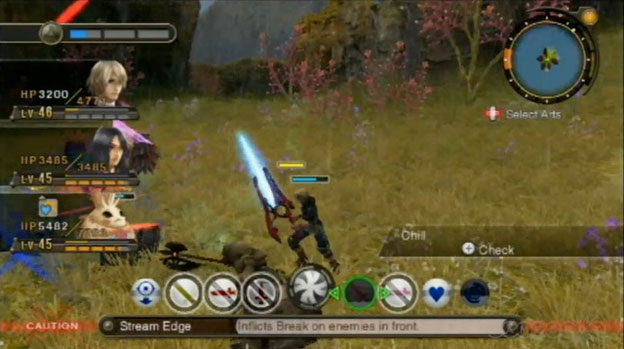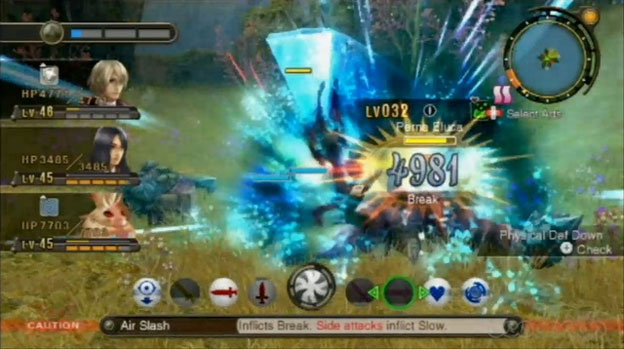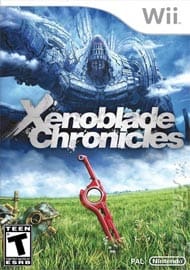This Is the Power of the Monado
Xenoblade Chronicles has had a long trip to North America, coming here nearly nine months after it was released in Europe. Nintendo of America seems to have responded either to strong fan pressure to bring over one of the few epic RPGs available for the Wii, or simply to have deemed European sales strong enough to bring the game over. Either way, RPG fans should be grateful to have the opportunity to play this game, which very well could be the greatest JRPG of this generation. Xenoblade is a huge, impressive game with a ton of heart and many unique aspects that mean it will appeal both to JRPG fans and to critics of the genre.
Players will first notice Xenoblade’s uniqueness in its setting. Xenoblade’s world is empty save for two massive titans, the Bionis and Mechonis, who have gone dormant after wearing each other out in a world-shattering battle ages ago. The main action takes place on the Bionis, which has become the home to several sentient races and an impressive diversity of ecosystems. When the robotic Mechon from Mechonis attack the carbon-based peoples of the Bionis, the stage is set for epic adventure. Journeying from the Bionis’ knee up to its head is certainly more interesting than traveling over the traditional RPG map, and is the first of many ways that this game breaks the norms of JRPG tradition without departing from it entirely. The overall story of the game makes sense and has various interesting twists and turns, some of which are easily predictable and some of which aren’t, and the game does a good job of making the player care about the world and the people in it.

Xenoblade’s characters form the heart and soul of the game’s experience, and the cast is both loveable and believable. The main character, Shulk, is a sweet, shy, self-doubting nerd who finds his inner courage when the Mechon attack his home. Accompanied by his boisterous but somewhat dim-witted bestie Rhyne, Shulk goes on a mission to exact revenge on the Mechon and drive them from the Bionis. In the process, the two gain numerous allies who become treasured friends during the adventure. Each of these characters has positive and negative attributes (they’re even identified in the characters’ skill trees) that form the basis of realistic personalities, and the development that the characters and their relationships experience through the adventure is both subtle and pleasing.
Getting the most out of Xenoblade’s characters involves developing affinity between party members by having them battle together, assist each other in battle when they’re afflicted by a status condition, give each other gifts, and complete side quests while in the same group. There are optional “heart-to-heart” scenes scattered through the game’s world that the player can access once two characters hit a particular affinity level with each other. Choosing different dialogue options in these scenes can cause them to play out very differently, and choosing the best responses causes characters to become much closer to each other. The heart-to-hearts range from funny to touching, and do a lot to flesh out the relationships between the party members.
As can be seen by the importance of character relationships, one of Xenoblade’s major themes is how a strong group of friends can give each other courage to fight impossible odds. Fortunately, Xenoblade approaches this topic in a far more mature and realistic manner than most JRPGs. The game’s issues are presented via ordinary discussions and arguments rather than speeches and soliloquies, and it’s gratifying to see this group of friends banter and bicker like real friends do. As a female gamer, I was particularly pleased to see the game’s female characters develop strong bonds of friendship with each other, something that doesn’t always happen in games, which tend to focus on male-male and male-female dynamics.

This theme of friendship and teamwork is strongly reflected in the game’s battle system, a real-time affair in which the player controls one lead character while two A.I.-controlled party members assist. Characters auto-attack enemies by default, and the player fires off abilities in order to prevail in battle. Unlike many games, the main character Shulk isn’t required to be in the battle party at all times, though the power of his sword, the Monado, will be required against Mechon enemies during the first half of the game. Players will get the most of out the game by trying out the various characters, each of which has a unique set of skills and battle style. An MMORPG-style party setup of tank, damage-dealer, and healer is useful for much of the game, but skilled players can take advantage of the game’s flexible character customization system to develop any number of effective character combinations in battle.
Whichever battle party is chosen, character skills sets are designed to complement each other. With the right combination of party members and skill sets, monsters can be weakened, then knocked down, then stunned while knocked down, greatly assisting the party against difficult foes. No single character can pull off the skill combinations needed to do all these things, but fortunately the game’s A.I. is relatively decent, so the A.I.-controlled party members will work together with the player-controlled character in these combination attacks. For maximum effectiveness, however, a gauge that fills during battle can be used to initiate a group combination attack, during which the battle briefly becomes turn-based and the player is allowed to select skills from each member of the party in turn. The greater the affinity between party members, the longer the player can keep the combination attack going, allowing for massive damage to the enemy or emergency directed healing. It’s a fun, quick-moving, and highly strategic battle system that will need to be mastered in order to tackle the game’s most challenging foes. It’s easy to control the battles as well, be it with the Wiimote/nunchuck combination or with a Classic Controller.

Beyond the RPG basics of plot, characters, and battles, there are a number of things that set Xenoblade apart. As is common in JRPGs, there are a ton of quests and side activities to engage in, but not only are these activities entirely optional, the game’s systems are set up to be very user-friendly and remove much of the tedium we’re used to seeing from JRPGs. Players can save anywhere and (except during a few critical plot points) travel instantly to previously visited locations. There’s a day-night cycle and weather system that alter the world and its inhabitants, but the player has access to the game’s clock and can change the time or fast forward through hours if a particular kind of weather is desired. There are side quests that can disappear after certain plot points, but they’re helpfully marked in the quest log so that the player knows that they should be prioritized for completion. These ease-of-use improvements are a breath of fresh air for JRPG gamers who are used to things like save points and pointless waiting around during day/night cycles.
There’s an impressive amount of character customization in the game as well. Players choose a skill loadout for each character and can choose where to place each skill on the skill bar. Skill points are spent to upgrade skills, and each character has a set of talent trees that the player can choose to develop over the course of the game. As character affinity increases, characters can use each other’s talents, a feature that allows players to compensate for weaknesses and enhance individual character strengths. A gem crafting system allows armor sets to be enhanced, and all these systems put together mean that skilled players can create an impressively powerful party able to down enemies that are far higher level than the characters.
Xenoblade shines in the art and music departments as well as gameplay. Although graphics aficionados may find themselves wishing the game’s lush environments and character designs could be rendered in HD, Xenoblade makes the best of the Wii’s graphical limitations by rendering a huge world that is frankly beautiful to look at. From sweeping plains roamed by herds of buffalo-like creatures to a jungle stalked by gigantic dinosaurs to a swamp that turns into a psychedelic wonderland at night, Xenoblade’s world has been more interestingly and fully realized than that of any game I’ve played in a long time. The only areas that fail to visually impress are those that heavily feature the Mechon and are disappointingly gray and brown—though some of the larger Mechon are still quite impressive to see. The character designs are nice as well, especially since every piece of armor is visually rendered on the party members, but they do suffer a bit from pixels and jagginess.
The British voice cast in Xenoblade lends a ton of personality to the game, and is excellent with the exception of token non-human party member Riki, who sounds like a Muppet with broken vocal chords. The characterization and emotional nuance given to each character by the voice actors is well above the usual level of video game voiceovers, particularly those found in translated Japanese games. The music is no slouch, either, with pumped-up battle themes and a score that suits the game’s environments well.

Of course, Xenoblade isn’t perfect. The game’s side quests are mostly fairly uninteresting item collection or monster-slaying affairs, though a few have good storylines behind them, and one side area that has the player rebuilding a ruined town is quite interesting and fun. There isn’t a good way to find specific NPCs with the information given in-game (though their general locations and schedules are listed, at least), leading to occasional frustrating searches through the game’s larger towns. The characters’ in-battle banter is fired off a bit too frequently, causing the battles to be a wash of chatter that can grate at times—though many players will find themselves repeating regular character catch phrases like, “It’s Rhyne time!”
Finally, the armor sets on some of the female characters are frequently too impractical and skimpy for the game’s generally serious tone. I found myself sticking with sub-optimal armor sets on some characters simply because I didn’t find buttless pants or bikini tops to be particularly appropriate for the situation or for those characters’ personalities. While there are silly and skimpy armor sets available for the male characters as well, they’re far less frequent and easier to avoid than the ones for the women.
These complaints are quite minor, however, given Xenoblade’s impressive scope and high-quality setting, story, characters, and gameplay. These features combined with the tremendous amount of heart and tedium-reducing gameplay elements make it an excellent game in general and one of the best JRPGs of this generation. JRPG fans who have been disappointed by this generation’s offerings should not hesitate to play Xenoblade Chronicles, but gamers who aren’t always enamored of JRPGs should give it a try as well. It will, however, take a major chunk of time to complete. Although it’s possible to finish Xenoblade Chronicles in 40-60 hours, a completionist playthrough will approach 200 hours due to the huge number of side activities, areas to explore, and seriously challenging late-game enemies.
Xenoblade Chronicles is such a huge, complex, and epic game that I can’t possibly cover everything it offers in a single review. All I can say is that it has earned the first 5.0 score I’ve given, and I’ve had the honor to play quite a few excellent games for review. Xenoblade just has something special—a full package that will appeal to a wide variety of gamers and has thrilled thousands who have played it since its European release. If you’re even remotely considering getting this game, I encourage you to go out and buy it. Chances are you will not be disappointed.
RATING OUT OF 5 RATING DESCRIPTION 4.5 Graphics
Making the best of the Wii’s graphical capabilities, Xenoblade presents an impressively huge and beautiful world. 4.5 Control
The game works well with either the Wiimote/nunchuck or Classic Controller. 4.7 Music / Sound FX / Voice Acting
An excellent soundtrack and great voice acting make Xenoblade a pleasure to listen to. 5.0 Play Value
Xenoblade’s gigantic number of side quests and optional challenges cause a thorough playthrough to last well over 100 hours. 5.0 Overall Rating – The Best
Not an average. See Rating legend below for a final score breakdown.
| Review Rating Legend | |||
|---|---|---|---|
| 0.1 – 1.9 = Avoid | 2.5 – 2.9 = Average | 3.5 – 3.9 = Good | 4.5 – 4.9 = Must Buy |
| 2.0 – 2.4 = Poor | 3.0 – 3.4 = Fair | 4.0 – 4.4 = Great | 5.0 = The Best |
Game Features:
